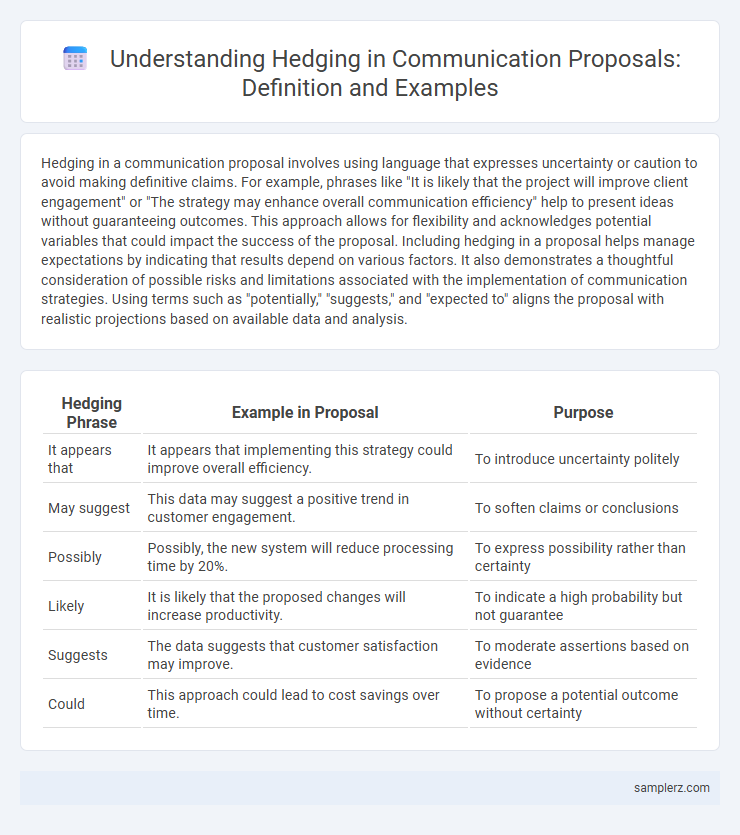Hedging in a communication proposal involves using language that expresses uncertainty or caution to avoid making definitive claims. For example, phrases like "It is likely that the project will improve client engagement" or "The strategy may enhance overall communication efficiency" help to present ideas without guaranteeing outcomes. This approach allows for flexibility and acknowledges potential variables that could impact the success of the proposal. Including hedging in a proposal helps manage expectations by indicating that results depend on various factors. It also demonstrates a thoughtful consideration of possible risks and limitations associated with the implementation of communication strategies. Using terms such as "potentially," "suggests," and "expected to" aligns the proposal with realistic projections based on available data and analysis.
Table of Comparison
| Hedging Phrase | Example in Proposal | Purpose |
|---|---|---|
| It appears that | It appears that implementing this strategy could improve overall efficiency. | To introduce uncertainty politely |
| May suggest | This data may suggest a positive trend in customer engagement. | To soften claims or conclusions |
| Possibly | Possibly, the new system will reduce processing time by 20%. | To express possibility rather than certainty |
| Likely | It is likely that the proposed changes will increase productivity. | To indicate a high probability but not guarantee |
| Suggests | The data suggests that customer satisfaction may improve. | To moderate assertions based on evidence |
| Could | This approach could lead to cost savings over time. | To propose a potential outcome without certainty |
Understanding Hedging in Proposal Communication
Hedging in proposal communication involves using cautious language to express suggestions or predictions without committing to absolute certainty, such as phrases like "it appears" or "this approach may improve." This technique helps manage expectations and reduces the risk of overpromising by allowing flexibility in outcomes and interpretations. Effective hedging enhances clarity and professionalism, fostering trust and openness between parties during negotiations.
Common Hedging Phrases in Proposals
Common hedging phrases in proposals include words like "suggests," "may," and "likely," which help soften claims and avoid overcommitment. Phrases such as "to the best of our knowledge" and "based on preliminary data" are used to indicate uncertainty or provisional findings. Employing these hedging expressions enhances the proposal's credibility by acknowledging potential limitations while emphasizing confidence in the presented information.
The Role of Modal Verbs in Proposal Hedging
Modal verbs such as "may," "could," and "might" play a crucial role in proposal hedging by softening statements and reducing commitment to specific outcomes. These verbs help convey uncertainty or flexibility, making proposals appear more cautious and negotiable. For example, using phrases like "This approach may improve efficiency" allows for suggestion without guaranteeing results, thereby managing expectations effectively.
Sample Sentences Using Hedging in Proposals
Hedging in proposals often involves using cautious language to soften claims and manage expectations, such as "This approach may improve efficiency under certain conditions" or "Results are likely to vary depending on resource availability." Phrases like "It is possible that," "There appears to be," and "Preliminary data suggests" exemplify hedging strategies that enhance credibility and reduce commitment risk. Employing hedging helps address uncertainties and facilitates persuasive yet flexible communication in professional proposals.
Benefits of Hedging Language in Business Proposals
Hedging language in business proposals, such as using terms like "may," "potentially," or "could," enhances flexibility and reduces the risk of over-commitment, allowing businesses to navigate uncertainties effectively. This strategic communication fosters trust by managing expectations and demonstrating a realistic understanding of market variables. Employing hedging improves negotiation outcomes by creating space for adjustments and collaborative problem-solving.
How Hedging Reduces Proposal Risk
Hedging in proposals involves using cautious language to manage expectations and mitigate potential misunderstandings, such as phrases like "subject to change" or "based on preliminary data." This strategic ambiguity reduces the risk of overcommitment and allows flexibility for unforeseen changes during project execution. Employing hedging protects both parties by clarifying uncertainties and minimizing the likelihood of disputes or renegotiations.
Effective Strategies for Hedging in Proposals
Effective strategies for hedging in proposals include using cautious language such as "may," "suggests," and "potentially" to present ideas without overcommitting. Incorporating phrases like "based on preliminary data" or "subject to further analysis" helps manage expectations and maintains flexibility. This approach enhances the proposal's credibility by acknowledging uncertainties while still advocating for the proposed solutions.
Comparing Direct and Hedged Statements in Proposals
Direct statements in proposals assert facts confidently, such as "Our solution increases efficiency by 20%." Hedged statements use cautious language to reduce risk, for example, "Our solution may increase efficiency by approximately 20%." Employing hedging in proposals enhances credibility by acknowledging uncertainties while maintaining persuasive communication.
The Impact of Hedging on Proposal Persuasiveness
Hedging in proposals, such as using phrases like "potentially improve" or "could enhance," softens claims to avoid overcommitment, increasing credibility and openness to feedback. This strategic uncertainty can make proposals appear more realistic and trustworthy, ultimately enhancing persuasiveness in business and academic settings. Research shows that moderate hedging balances confidence and caution, fostering positive reception from stakeholders and decision-makers.
Avoiding Over-Hedging in Proposal Writing
Avoiding over-hedging in proposal writing is crucial to maintain clarity and confidence in your communication. Phrases like "it might be possible" or "we could potentially" should be used sparingly to prevent weakening your message and appearing uncertain. Clear, assertive language enhances the proposal's professionalism and persuasive impact.

example of hedging in proposal Infographic
 samplerz.com
samplerz.com